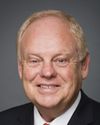Thank you, Mr. Chair and committee members, for allowing us to speak to the committee this afternoon. I'll read a prepared brief also.
Celebrating its 50th anniversary this year, the Geomatics Industry Association of Canada, formerly the Canadian Association of Aerial Surveyors, is the only national organization in Canada that advocates for geomatics on behalf of its members. The geomatics business in Canada is home to over 2,000 firms--small, medium, and large--that employ close to 25,000 employees across the nation. To gauge relative size, this is larger than the number of people employed in the pharmaceuticals business, as an example. The estimated annual gross revenue generated by these firms is over $2 billion, with approximately 25% of that being earned as export revenue.
What is geomatics? The definition from Wikipedia is as follows:
Geomatics (also known as geospatial technology or geomatics engineering) is the discipline of gathering, storing, processing, and delivering geographic information, or spatially referenced information.
Geomatics has traditionally been practised by the surveying, mapping, remote-sensing, cartography, photogrammetry, geodesy, hydrography, and geographic information system disciplines. In the past few decades, geomatics has rapidly evolved and grown into a modern cross-sector advanced technology discipline employing sophisticated approaches to creating and maintaining maps and imbedding those maps into the multiplicity of decision support systems that a digital society needs and uses. One common example is the vehicle navigation systems that we use today. This evolution has significantly broadened the range of sectors that employ geomatics and has also substantially increased the need for up-to-date, modern national mapping, which is the foundational digital infrastructure required to support the efficient application of geomatics across our society.
Commercial companies, such as Google, NAVTEQ, and Microsoft, to name a few, rely 100% on the business of geomatics to create their maps. Microsoft Bing estimates that 35% of all Bing search engine searches have a geographic or location component. Most of this available mapping is of a resolution and accuracy that allows it to be used for general consumer consumption but does not meet the demanding business and societal needs required for in-depth geomatics analysis for, say, flood mapping, transportation and infrastructure development, and detailed exploration activities. This available mapping from commercial companies also tends to be focused on areas where a commercial market is available, as opposed to over all of Canada; thus it does not consistently meet many of the demands of our society.
Who uses geomatics? The users of geomatics are truly cross-sectoral. Users come from sectors that include infrastructure and critical infrastructure; transportation--land, air, and sea; emergency management; public health and biosecurity; resource management; mining; petroleum resources; the environment; national defence and border security; utilities and telecommunications; forestry; fisheries; manufacturing; and trade and retail services.
Further, governments are the largest consumer of geomatics data and services--municipal, regional, provincial, territorial, and federal.
For the past 20 or more years, advancements in applied geomatics in Canada have taken place primarily in the private sector, some independently funded and some in cooperation with universities and limited government programs. Examples include IRAP, GEOIDE, GeoConnections, Tecterra.
Whereas Canada was an international leader in geomatics post-World War II and into the 1980s, its status and ability at the federal level has fallen behind much of the developed world. There are many reasons for this, but GIAC believes the lack of a coherent, practical, and actionable national strategy and plan is at the core of this decline.
Most of Canada's national maps are antiquated, with base data often more than 30 years old. Canada's mapping information is incomplete, and the level of accuracy and resolution of national maps is inadequate and needs to be enhanced to include detail adherent to the needs of modern cross-sectoral geomatics users.
As a result, in order to support effective decision-making, public and private activities across many sectors are forced to use out-of-date mapping, create new mapping, or acquire other mapping for their specific projects. The cumulative effect of this situation across our society is to add substantial costs and time to all projects in sectors that require mapping. This is a productivity drag on Canada's economy.
There is not a one-size-fits-all solution, but the technology and know-how exist to create a modern national map in Canada. However, without a cohesive national multi-sector strategy to establish standards, develop an execution, delivery, and maintenance model, and ensure that data when collected is stored and accessible, investments made by governments and the private sector will continue to be ad hoc and incomplete.
Beyond mapping, a national geomatics strategy would also address the strategic importance of geomatics technology to a modern economy and society by helping facilitate the effective application of geomatics in our education systems, our research, development, and commercialization activities, our skills development programs, and with our key national policy issues, such as energy, sovereignty, environment, public safety, natural resources, health, and others.
Having up-to-date and accurate mapping data openly and freely available, based on user models that can be well defined, would allow Canada to efficiently direct resources effectively, plan for future growth and development, and establish sovereignty over our borders.
Governments need to care, because the current situation is negatively impacting our national productivity, competitiveness, and levels of innovation.
Geomatics is a modern technology that Canada needs to leverage more effectively in order to compete effectively in a global economy. This is especially true for more remote areas such as Canada's north, where the lack of adequate geomatics information hinders ongoing activities as well as future economic development.
There are a number of examples of how government can partner with industry to ensure accessible data is available and to work together to prioritize the gaps in existing locations. In the field of geomatics, the following program is an example that is in place in Alberta: Spatial Data Warehouse Ltd. is an Alberta-registered, not-for-profit company created in 1996 to take over and fund digital mapping activities that were previously undertaken and funded by the Government of Alberta. It has proven to be one of the most successful P3 initiatives within the province of Alberta. Spatial Data Warehouse's objective is to provide for the long-term management, updating, storage and distribution, and associated funding of digital mapping data sets that collectively make up Alberta's digital mapping infrastructure.
The following recommendations were made by GIAC in its pre-budget submission to the House finance committee in both the fall of 2009 and the fall of 2010, and were supported by explanatory visits to over 40 members of Parliament in November 2009 and November 2010.
One, GIAC recommends that the Government of Canada fund the development of Canada's first comprehensive multi-sector national geomatics action plan by the end of 2010. This would be Canada's first comprehensive multi-sector national geomatics action plan. The objective of the NGAP, as it's called, would be to strengthen the use of geomatics and promote it as an essential tool upon which decisions that impact our quality of life, innovation, productivity, and global competitiveness rely.
The NGAP would be facilitated and compiled by an independent policy and research organization working through a national forum that would consist of representatives of government, industry, academia, and the user community. The NGAP would address the need for a modern approach to national mapping as well as the need for the more effective application of geomatics in our education systems, in our research and development and commercialization activities, and in our skills development programs.
Two, GIAC recommends that the Government of Canada invest up to $250 million over a five-year period in a national imagery acquisition program. This program would satisfy the need for modern national mapping by leveraging satellite and airborne imaging and digital elevation models that have become the preferred option for mapping users. These modern maps are directly usable but can also be employed to modernize the maintenance of other key types of mapping, such as road mapping, topographic mapping, and land use mapping, and others.
GIAC's vision of the NIAP is for Canada to establish and sustain a comprehensive repository of up-to-date imagery and digital elevation models that will be accessible and freely available to all federal, provincial, territorial, and municipal governments, the private sector, non-government organizations, communities of interest, and the public.
Notwithstanding the above recommendations, in 2011 GIAC supported a submission by one of its members to the House finance committee as part of its pre-budget consultations, recommending a series of pilot projects that could lay the foundation to support the above-mentioned national geomatics action plan.
National leadership would allow for the establishment of standards and avoid issues of interprovincial effects of development caused by having incompatible data--i.e. projects that span provinces are currently disparate when it comes to geospatial data. This leadership would also provide for a consistent inventory for federal government property across Canada, and having a national perspective will better prioritize data acquisition or updating for all levels of government.
The benefits derived from employing geomatics more effectively can be seen in a report prepared for the Canadian Council on Geomatics, which pegs gains to GDP at 0.6% to 1.2%, or in the range of $9.5 billion to $18.9 billion per year. In a similar analysis funded by two private Canadian geomatics firms in 2010, Dr. Ian Lee, the MBA director of the Carleton University Sprott School of Business, predicted gains in the range of $7.3 billion to $14.4 billion.
In closing, Mr. Chair, the Prime Minister has made Arctic sovereignty a priority, but only a small percentage of Canada's north has recent geomatics data. Programs such as the GEM program would gain much greater benefit if those researchers had ready access to better, up-to-date, and open geospatial data, as opposed to having to source it ad hoc using funds extracted from already stretched research budgets.
The solution is through GIAC's recommendations for a national geomatics action plan and a national image reacquisition program. A national geomatics warehouse containing all current and future data that all could freely access and use as needed would be created. This could be built on a sustainable business model, ensuring continued relevance of this essential digital infrastructure that would continue to facilitate the effective development and growth of the north.
On behalf of the Geomatics Industry Association of Canada, I would like to thank the Standing Committee on Natural Resources for the opportunity to speak before you today. I welcome any questions you might have.










